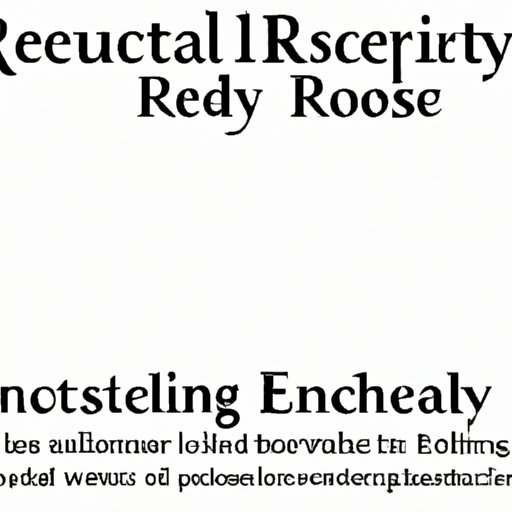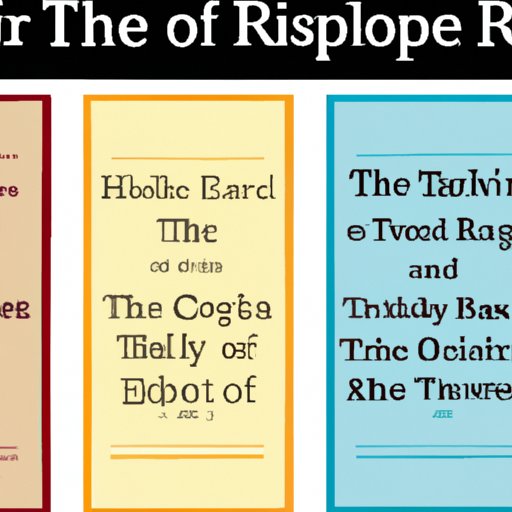Introduction
Realism is a literary movement that emerged in the mid-nineteenth century and has since become one of the most influential genres in literature. Realist literature focuses on accurately depicting the lives and experiences of everyday people, often in a naturalistic or unromanticized way. It is often characterized by its attention to detail, its focus on characters from lower classes, and its exploration of social issues. This article will explore realist literature in greater depth, examining its primary themes, common characteristics, major authors and works, and its impact on modern culture.

Exploring Realist Literature: A Comprehensive Overview
In order to better understand realist literature, it is important to first consider what it is and what themes it commonly explores. Realist literature is characterized by its attention to detail, its focus on characters from lower classes, and its exploration of social issues. It is often seen as a reaction to romanticism, which often idealizes human experience and downplays the harsher realities of life. By contrast, realist literature seeks to accurately depict the lives and experiences of everyday people.
What is Realist Literature?
Realist literature is an umbrella term for a broad range of literature that seeks to accurately portray the lives and experiences of everyday people. It is often characterized by its attention to detail, its focus on characters from lower classes, and its exploration of social issues. Realist literature can be found across all genres, including novels, short stories, plays, and poetry.
Primary Themes in Realist Literature
The primary themes explored in realist literature include poverty, class struggle, corruption, and power. These themes are often explored through the lens of everyday people, allowing readers to gain insight into the struggles and hardships faced by those who are not part of the elite or upper classes. Other themes explored in realist literature include gender roles, religion, morality, and family dynamics.
Major Authors and Works
Realist literature has been written by many authors throughout history, but some of the most notable authors and works include Charles Dickens’s A Tale of Two Cities, Gustave Flaubert’s Madame Bovary, and Leo Tolstoy’s Anna Karenina. These works have had a lasting impact on literature and culture, and they remain some of the most beloved and influential realist works of all time.
An Analysis of Realist Literature: Examining Its Characteristics and Impact
Now that we have a basic understanding of what realist literature is and what themes it commonly explores, let’s take a closer look at some of its common characteristics and how it has influenced culture. Realist literature is often characterized by its attention to detail, its focus on everyday people, and its exploration of social issues. It also frequently uses realism and naturalism to accurately depict the lives and experiences of its characters.
Common Characteristics of Realist Literature
Realist literature is characterized by its attention to detail, its focus on characters from lower classes, and its exploration of social issues. It often uses realism and naturalism to accurately depict the lives and experiences of its characters. Additionally, realist literature often features characters who are struggling with moral issues, such as poverty, class struggle, corruption, and power. In addition to these themes, realist literature also often explores gender roles, religion, and family dynamics.
How Realist Literature Influenced Culture
Realist literature has had a profound influence on culture and society. Many of the works of realist literature have become iconic and have shaped the way we think about certain topics. For example, Charles Dickens’s novel A Tale of Two Cities has become a classic work of literature and is often studied in classrooms around the world. Similarly, Gustave Flaubert’s Madame Bovary has been praised for its accurate depiction of 19th-century French society and has been adapted into numerous films and television shows. Finally, Leo Tolstoy’s Anna Karenina has become a beloved classic and is often seen as one of the greatest novels of all time.

Realist Literature Through the Ages: How It Evolved Over Time
Realist literature has evolved over time, with different periods of history producing distinct variations of the genre. Let’s take a look at the evolution of realist literature throughout the ages.
Greek and Roman Realist Literature
Realist literature began in ancient Greece and Rome. Homer’s The Odyssey is often cited as one of the earliest examples of realist literature, as it features realistic characters and offers an insight into the lives of everyday people. Other notable works from this period include Virgil’s The Aeneid and Ovid’s Metamorphoses.
Medieval Realist Literature
Realist literature continued to evolve during the Middle Ages. Geoffrey Chaucer’s The Canterbury Tales is often considered to be one of the most important works of realist literature from this period. It features realistic characters and explores themes such as class struggle and power dynamics. Other notable works from this period include Dante’s The Divine Comedy and Jean de Meun’s Roman de la Rose.
Renaissance Realist Literature
During the Renaissance, realist literature flourished. William Shakespeare’s plays are often cited as some of the best examples of realist literature from this period. His plays feature realistic characters and explore themes such as love, power, and morality. Other notable works from this period include Miguel de Cervantes’s Don Quixote and Thomas More’s Utopia.
Modern Realist Literature
Realist literature continued to evolve in the modern era. Some of the most iconic works of realist literature from this period include Charles Dickens’s A Tale of Two Cities, Gustave Flaubert’s Madame Bovary, and Leo Tolstoy’s Anna Karenina. These works have had a lasting impact on literature and culture, and they remain some of the most beloved and influential realist works of all time.

A Closer Look at Realist Literature: A Comparison of Major Works
Now that we’ve discussed the evolution of realist literature, let’s take a closer look at some of its most iconic works. We will compare the three works mentioned above: Charles Dickens’s A Tale of Two Cities, Gustave Flaubert’s Madame Bovary, and Leo Tolstoy’s Anna Karenina.
A Tale of Two Cities by Charles Dickens
A Tale of Two Cities is a classic work of realist literature. Set during the French Revolution, it follows the story of two men from different backgrounds who are caught in the chaos and violence of the revolution. It is a story of love, loyalty, and redemption, and it explores themes such as poverty, class struggle, and power.
Madame Bovary by Gustave Flaubert
Madame Bovary is a classic work of realist literature. It tells the story of Emma Bovary, a woman trapped in an unhappy marriage who attempts to escape her mundane life through affairs and extravagant spending. It is a story of love, longing, and tragedy, and it explores themes such as gender roles, morality, and power.
Anna Karenina by Leo Tolstoy
Anna Karenina is a classic work of realist literature. It tells the story of Anna Karenina, a married woman who embarks on a passionate affair with a man who is not her husband. It is a story of love, betrayal, and redemption, and it explores themes such as class struggle, power, and family dynamics.
The Power of Realist Literature: Examining Its Influence on Modern Culture
Realist literature has had a profound influence on modern culture. It has been used to shape social and political movements, to explore contemporary issues, and to create art and literature that reflects the experiences of everyday people. Let’s take a look at some of the ways in which realist literature has impacted modern culture.
How Realist Literature Shaped Social and Political Movements
Realist literature has been used to shape social and political movements throughout history. For example, A Tale of Two Cities was used to raise awareness about the plight of the lower classes during the French Revolution, while Madame Bovary was used to explore the plight of women in 19th-century France. Similarly, Anna Karenina was used to explore the power dynamics between the upper and lower classes in Russia.
The Impact of Realist Literature on Contemporary Art and Literature
Realist literature has also had a profound influence on contemporary art and literature. Many modern writers and artists have been inspired by realist literature, using it as a source of inspiration for their own works. For example, many modern writers have been inspired by the works of Charles Dickens, Gustave Flaubert, and Leo Tolstoy, creating works that explore similar themes and examine the lives of everyday people.
Conclusion
Realist literature is a genre of literature that seeks to accurately depict the lives and experiences of everyday people. It is characterized by its attention to detail, its focus on characters from lower classes, and its exploration of social issues. Throughout history, realist literature has evolved, with different periods of history producing distinct variations of the genre. Some of the most iconic works of realist literature include Charles Dickens’s A Tale of Two Cities, Gustave Flaubert’s Madame Bovary, and Leo Tolstoy’s Anna Karenina. Realist literature has had a profound influence on modern culture, shaping social and political movements and inspiring contemporary art and literature.
Summary of Realist Literature
Realist literature is a genre of literature that seeks to accurately depict the lives and experiences of everyday people. It is characterized by its attention to detail, its focus on characters from lower classes, and its exploration of social issues. Throughout history, realist literature has evolved, with different periods of history producing distinct variations of the genre. It has had a profound influence on modern culture, shaping social and political movements and inspiring contemporary art and literature.
Final Thoughts on Realist Literature
Realist literature has had a lasting impact on literature, culture, and society. Its ability to accurately depict the lives and experiences of everyday people has allowed it to shape social and political movements and to inspire contemporary art and literature. As such, realist literature remains one of the most influential genres in literature today.
(Note: Is this article not meeting your expectations? Do you have knowledge or insights to share? Unlock new opportunities and expand your reach by joining our authors team. Click Registration to join us and share your expertise with our readers.)
